Intel’s Silvermont Architecture Revealed: Getting Serious About Mobile
by Anand Lal Shimpi on May 6, 2013 1:00 PM EST- Posted in
- CPUs
- Intel
- Silvermont
- SoCs
ISA
The original Atom processor enabled support for Merom/Conroe-class x86 instructions, it lacked SSE4 support due to die/power constraints; that was at 45nm, at 22nm there’s room for improvement. Silvermont brings ISA compatibility up to Westmere levels (Intel’s 2010 Core microprocessor architecture). There’s now support for SSE4.1, SSE4.2, POPCNT and AES-NI.
Silvermont is 64-bit capable, although it is up to Intel to enable 64-bit support on various SKUs similar to what we’ve seen with Atom thus far.
IPC and Frequency
The combination of everything Intel is doing on the IPC front give it, according to Intel, roughly the same single threaded performance as ARM’s Cortex A15. We’ve already established that the Cortex A15 is quite good, but here’s where Silvermont has a chance to pull ahead. We already established that Intel’s 22nm process can give it anywhere from a 18 - 37% performance uplift at the same power consumption. IPC scaling gives Silvermont stable footing, but the ability to run at considerably higher frequencies without drawing more power is what puts it over the top.
Intel isn’t talking about frequencies at this point, but I’ve heard numbers around 2 - 2.4GHz thrown around a lot. Compared to the 1.6 - 2GHz range we currently have with Bonnell based silicon, you can see how the performance story gets serious quickly. Intel is talking about a 50% improvement in IPC at the core, combine that with a 30% improvement in frequency without any power impact and you’re now at 83% better performance potentially with no power penalty. There are other advantages at the SoC level that once factored in drive things even further.
Real Turbo Modes & Power Management
Previous Atom based mobile SoCs had a very crude version of Intel’s Turbo Boost. The CPU would expose all of its available P-states to the OS and as it became thermally limited, Intel would clamp the max P-state it would expose to the OS. Everything was OS-driven and previous designs weren’t able to capitalize on unused thermal budget elsewhere in the SoC to drive up frequency in active parts of chip. This lack of flexibility even impacted the SoC at the CPU core level. When running a single threaded app, Medfield/Clover Trail/et al couldn’t take thermal budget freed up by the idle core and use it to drive the frequency of the active core. Previous Atom implementations were basically somewhere in the pre-Nehalem era of thermal/boost management. From what I’ve seen, this is also how a lot of the present day ARM architectures work as well. At best, they vary what operating states they expose to the OS and clamp max frequency depending on thermals. To the best of my knowledge, none of the SoC vendors today actively implement modern big-core-Intel-like frequency management. Silvermont fixes this.
Silvermont, like Nehalem and the architectures that followed, gets its own power control unit that monitors thermals and handles dynamic allocation of power budget to various blocks within the SoC. If I understand this correctly, Silvermont should expose a maximum base frequency to the OS but depending on instruction mix and available TDP it can turbo up beyond that maximum frequency as long as it doesn’t exceed TDP. Like Sandy Bridge, Silvermont will even be able to exceed TDP for a short period of time if the package temperature is low enough to allow it. Finally, Silvermont’s turbo can also work across IP blocks: power budget allocated to the GPU can be transferred to the CPU cores (and vice versa).
By big-core standards (especially compared to Haswell), Silvermont’s turbo isn’t all that impressive but compared to how things are currently handled in the mobile space this should be a huge step forward.
On the power management side, getting in and out of C6 should be a bit quicker. There's also a new C6 mode with cache state retention.


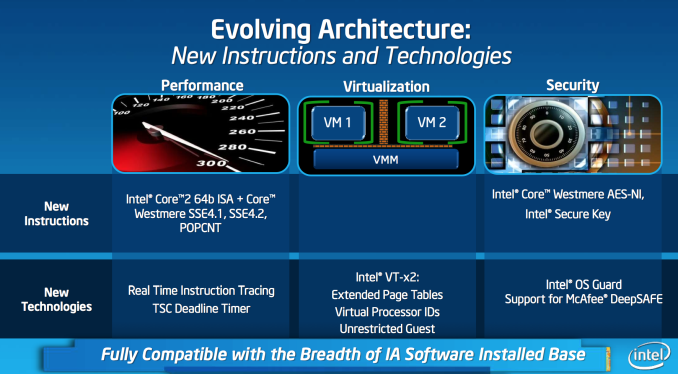
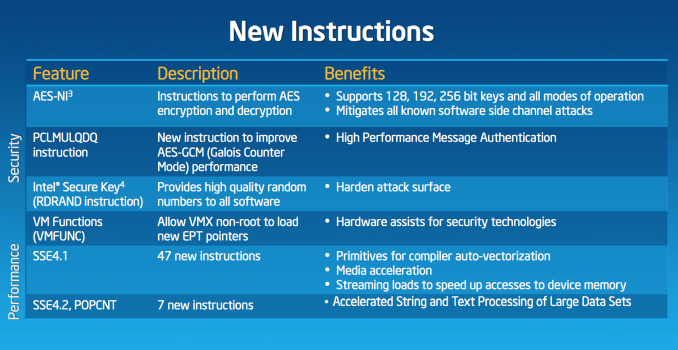
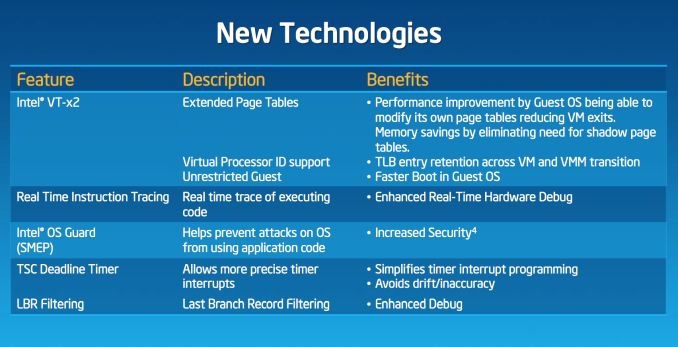
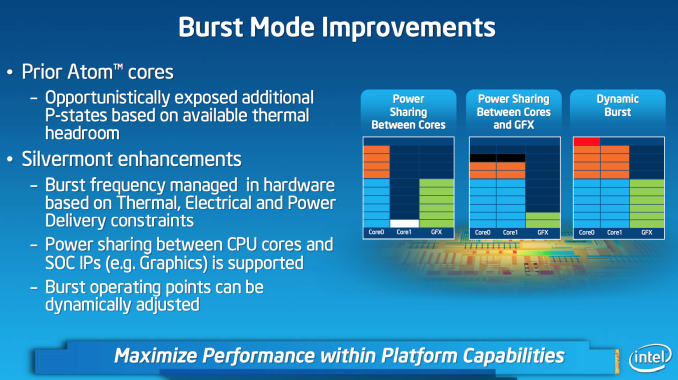
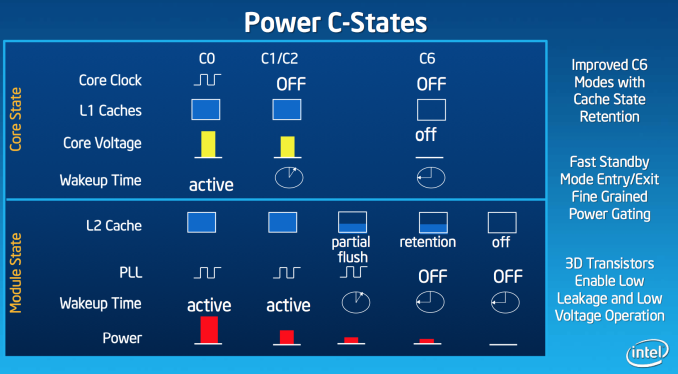








174 Comments
View All Comments
R0H1T - Tuesday, May 7, 2013 - link
Let's see, umm Snapdragon 600 & then there's this soon to be released 800 ? So lemme get this straight, an unreleased product vs one that was available last year, Intel's latest(future indefinite) vs old/dated(relatively) from ARM seems fair to me !ssiu - Monday, May 6, 2013 - link
Exactly the 2 points I wonder about too:(1) GPU performance -- 1/4 of an HD4000, about iPad 4 level -- so slower than e.g. PowerVR Rogue which should come out around the same time
(2) more importantly, even if Intel can make competitive/superior product, can it survive on such low margin?
zeo - Wednesday, May 8, 2013 - link
Well, yes and no on point 1... The iPad is using a quad SGX544, and Rogue doesn't improve performance by that massive amount that a single Rogue/Series 6 could beat a quad Series 5. So it's not that Rogue will be better than the Bay Trail GMA but can scale higher with a multiple configuration!On the margins, Intel is lowering their costs moving to 22nm FAB and despite the declining PC market they're still doing well and so should be fine for the foreseeable future... They'll have to do terribly in all markets to really start hurting now and that's not likely yet...
andrewaggb - Monday, May 6, 2013 - link
too early to say I think. This atom should be pretty good. if it's both twice as fast as the old atom and uses less power (which I believe is what they are trying to tell us), that's pretty good. It will be competing with 2nd gen a-15 designs or better, so the current performance claims are largely meaningless. GPU performance continues to be an issue, aiming for last years performance is definitely way too low. Fortunately gpu speed can normally be scaled more quickly than cpu speed, but intel seems to consistently underspec on gpu so I doubt they'll do better this time. Unless they go haswell style and have various different gpu skus. guess we'll see.Considering how much success rambus has had suing everybody I think if intel wanted to they could probably sue anybody working on advanced processor designs without sufficient licensing arrangements. Drive the minimum cost up a bit so the margins are higher.
R0H1T - Tuesday, May 7, 2013 - link
This comment is hilarious ~ "gpu speed can normally be scaled more quickly than cpu speed" that's only if you're packing moar cores i.e. like SNB<IVB<<Haswell !GPU's cannot be scaled for performance unless there's some major redesigns of the underlying architecture, like AMD's transition to GCN, so unless you've got some insider info into how Intel plans to use their superior Iris(Pro) graphics in Silvermont I see this myth, about Intel's superior graphics, of yours being busted yet again, only this time in the mobile arena !
ominobianco - Monday, May 6, 2013 - link
If you had actually read the article you would know that they are comparing against performance PROJECTIONS of competitors parts available at product launch time, NOT current parts.zeo - Wednesday, May 8, 2013 - link
Sorry but ARMv8 64bit aren't coming out till the later half of 2014 at the earliest and they're pushing to be on 16nm and not 20nm, which may delay them further!While there's no major improvements planned for ARM until then! Many of the original Cortex A15 SoC releases have been delayed from 2012 to 2013!
MrSpadge - Monday, May 6, 2013 - link
Error: On page 1 you correctly write "Remember that power scales with the square of voltage". Almost immediately followed by "At 1V, Intel’s 22nm process gives ... or at the same performance Intel can run the transistors at 0.8V - a 20% power savings."Ouch - forgot that square!
dusk007 - Monday, May 6, 2013 - link
I thought we would wait for 14nm for Intel to definitely pull ahead. This looks very promising.Now my perfect smartphone would sport a dual core Silvermont with a 4000mah battery, the HTC One camera and otherwise durable.
GPU I don't care as long as it is good enough for the GUI I don't play games that would require something fast. Thin? Not at the cost of a smaller battery.
I would love some feature phone like battery life. Triple what we have to deal with now would be incredible and possible it seems to me. Maybe the Motorola Phone X x86 Version can deliver that.
Camera is secondary and I don't need a 1080p screen. Just 4.3-4.5" of 720p and long battery life.
I feel like battery life is where this new generation can really promise new things. 32nm Atom already does really well in the tablets compared to quad core ARM competition. It will be a waste if they add 1500mah batteries though. I hope they finally realize as smartphones are mainstream that a lot of people would care first about battery life and second about 7mm thinness.
beginner99 - Tuesday, May 7, 2013 - link
Agree. Current phones are too big, 1080p is pretty much useless and wastes battery life and even the GPU in Medfield is good enough for the GUI. The lower screen resolution of course helps too with needing a not so good GPU. But with both you save on power. I want a phone I need to charge once a week not every day.